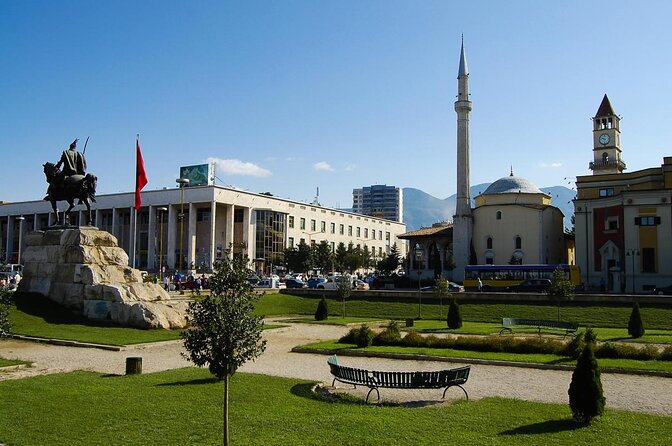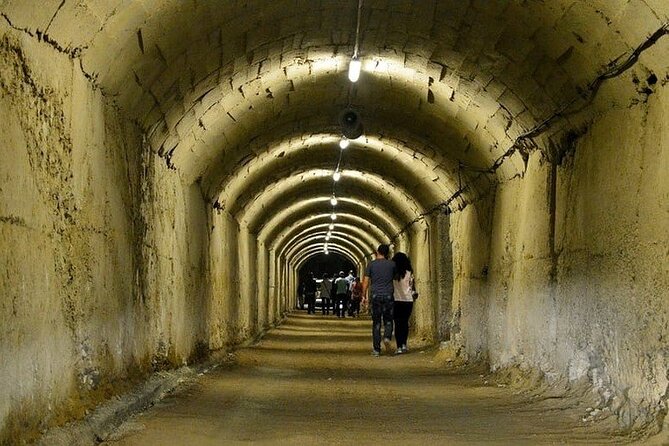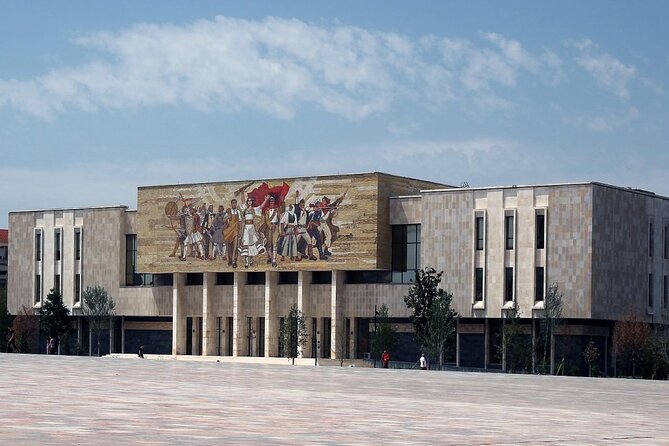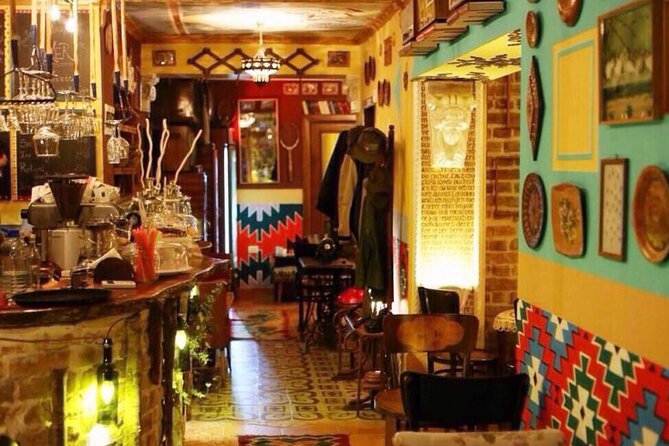In Tirana, the remnants of communism linger in ways that might surprise visitors. The imposing Pyramid of Tirana and eerie BunkArt1 stand as stark reminders of Enver Hoxha’s regime, while the National Historical Museum reveals the stories of a nation transformed. Murals and monuments scattered throughout the city echo socialist ideals, and locals have fascinating tales that weave together personal experiences and collective memory. But what does it really mean for Tirana today? To find out, one must explore the city’s unique blend of past and present, where history continues to shape the local identity.
Good To Know

- The National Historical Museum showcases exhibits on Albania’s communist era, illustrating its impact on society and daily life.
- BunkArt1, an underground bunker, hosts displays that explore Albania’s communist past and Cold War history through artifacts and multimedia.
- The Pyramid of Tirana, once Hoxha’s mausoleum, stands as a prominent symbol of the communist regime’s legacy in the city.
- Bar Komiteti offers a nostalgic atmosphere, reflecting the lifestyle and culture from the communist period through decor and ambiance.
- Murals and concrete structures throughout Tirana showcase socialist ideals, representing the cultural impact of communism on architecture and public art.
Historical Context of Communism in Albania
Communism left a significant mark on Albania‘s history, shaping its social and political landscape for decades.
After World War II, Albania became a Stalinist state under Enver Hoxha, who ruled with an iron fist. His regime focused on isolating the country from the West, promoting intense nationalism, and enforcing strict ideological conformity.
The government nationalized industries and collectivized agriculture, which led to significant economic struggles. Hoxha’s oppressive tactics included widespread censorship and political purges, leaving a legacy of fear and repression.
Even after the regime fell in the early ’90s, the echoes of that era still linger. Today, the remnants of communism are visible in the architecture and cultural psyche, making Albania a fascinating case study of resilience and transformation.
You can also read our reviews of more tours and experiences in Tirana.
Key Sites to Explore

The remnants of Albania’s communist past aren’t just stories from history books; they’re tangible experiences waiting to be explored.
In Tirana, visitors can dive into history at the National Historical Museum, where captivating exhibits reveal the country’s transformation during the communist era. Not far away, Bar Komiteti offers a unique vibe, serving coffee in a setting reminiscent of the old days. The atmosphere transports patrons back to a time when political discussions brewed alongside their espresso.
Another must-see is the infamous Pyramid of Tirana, once a mausoleum for Enver Hoxha, now a symbol of a bygone era. These sites provide a compelling glimpse into Albania’s complex history, making them essential stops for any curious traveler.
BunkArt1: A Cold War Relic

BunkArt1 stands out as a fascinating glimpse into Albania’s Cold War era, drawing visitors with its unique blend of history and art. Housed in a massive underground bunker, originally built to protect government officials from nuclear threats, it now hosts an impressive collection of exhibits that explore the country’s communist past.
Visitors can wander through the eerie hallways, exploring rooms filled with artifacts, photographs, and multimedia displays that tell stories of resilience and survival. The creative integration of contemporary art pieces adds a modern twist, making the experience even more engaging.
BunkArt1 offers a thought-provoking journey, reminding everyone of the complexities of Albania’s history while sparking conversations about the past and its impact on the present.
National Historical Museum Highlights
Stepping into the National Historical Museum is like opening a time capsule that reveals the rich tapestry of Albania’s past. Visitors find themselves immersed in exhibits showcasing everything from prehistoric artifacts to the turbulent events of the 20th century.
The museum’s vast collection includes stunning mosaics, traditional costumes, and weaponry, painting a vivid picture of Albania’s cultural evolution. One of the highlights is the impressive display on communism, illustrating the regime’s impact on daily life.
The museum also boasts a beautiful courtyard, perfect for a quick breather between exploring. With knowledgeable guides around, folks can dive deeper into the stories behind the exhibits, making this stop a must-see for anyone eager to understand Albania’s complex history.
The Cultural Impact of Communism
Communism left a lasting mark on Albanian culture, shaping everything from art to daily life in ways that are still felt today. The influence can be seen in various aspects, which include:
-
Art and Architecture: Massive murals and concrete structures reflect the ideology of the time, often glorifying socialist themes.
-
Literature and Music: Works from that era often carried political messages, intertwining nationalism with socialist ideals.
-
Social Norms: Community-focused living and collective events became ingrained in daily practices, fostering a sense of unity.
Today, remnants of this cultural impact linger in Tirana, creating a unique blend of the past with modern influences.
Visitors can’t help but notice how history continues to shape the city’s vibrant cultural scene.
Local Perspectives and Memories

Nostalgia often weaves through conversations among locals in Tirana as they share their memories of life under the communist regime. Many reminisce about the simpler times, laughing about their childhood games and the clandestine gatherings.
They paint vivid pictures of shared meals and the tight-knit communities that emerged despite the oppressive atmosphere. Some elders reflect on the fear and control, while others emphasize the resilience and camaraderie that developed in those years.
Younger generations, curious about their parents’ experiences, listen intently, trying to grasp the complexities of that era. These local perspectives create a rich tapestry of memories, blending both the painful and the fond, as Tirana continues to evolve while honoring its past.
Tips for Visiting Tirana
When planning a visit to Tirana, travelers should keep a few key tips in mind to make the most of their experience.
First off, embrace the local culture—try the delicious Albanian cuisine at a traditional restaurant.
Next, don’t skip the historical sites; a visit to BunkArt1 and the National Historical Museum is a must for those interested in the city’s communist past.
Lastly, get ready to walk! Tirana’s vibrant streets are best explored on foot, so wear comfortable shoes.
- Sample local dishes like byrek and tavë kosi.
- Visit BunkArt1 for a unique historical insight.
- Stroll through the city to soak up the lively atmosphere.
These tips will help ensure a memorable trip!
Ask Away

What Is the Price for Children Participating in the Tour?
The tour price doesn’t specify a discount for children, so it’s likely the same as adults. However, families should check directly with the provider for any special rates or offers for younger travelers.
Can I Join the Tour if I Have Dietary Restrictions?
She can definitely join the tour! The guide’s usually flexible, so it’s best to mention any dietary restrictions when booking. That way, they’ll make sure there’s something tasty for her to enjoy.
Are There Restrooms Available During the Tour?
During the tour, there’re restrooms available at key stops, ensuring comfort for everyone. Travelers can relax and enjoy the experience without worrying about finding facilities. It’s all about making the journey enjoyable!
What Should I Wear for the Walking Portions of the Tour?
For the walking portions, they recommend comfy shoes and light clothing. It’s smart to dress for the weather, too. Layers are great, since temperatures can change throughout the day. They’ll appreciate the comfort!
Is Photography Allowed at the Historical Sites Visited?
At the historical sites visited, photography’s usually allowed, but it’s best to check for any specific restrictions. Most travelers snap photos freely, capturing memories while enjoying the rich stories behind each location.
Final Words
Tirana’s communist traces offer a fascinating glimpse into Albania’s past, blending history with modern life. From the haunting BunkArt1 to the vibrant murals, there’s so much for visitors to discover. Locals’ stories add depth, making the experience even richer. Whether you’re wandering through the National Historical Museum or soaking in the architecture, exploring these remnants of communism can ignite a deeper understanding of the city’s journey. So, dive in and uncover the layers of Tirana’s unique history!
More Tour Reviews in Tirana
- Tirana: A walk through the history of Albania.
- From Tirana/Durrës/Golem: Theth, Blue Eye & Waterfall Tour
- Traditional Albanian Cooking Class in Tirana & Raki Tasting
- From Tirana: Bovilla Lake and Panorama Hike Day Trip
- Tirana: Virtual Tour of Art Bunkers Bunk’Art 1 and 2
- Discover Tirana: Panoramic Tour and Walk around the Artificial Lake
Not for you? Here's more nearby things to do in Tirana we have reviewed
- Tirana: A walk through the history of Albania.
- From Tirana/Durrës/Golem: Theth, Blue Eye & Waterfall Tour
- Traditional Albanian Cooking Class in Tirana & Raki Tasting
- From Tirana: Bovilla Lake and Panorama Hike Day Trip
- Tirana: Virtual Tour of Art Bunkers Bunk’Art 1 and 2
- Discover Tirana: Panoramic Tour and Walk around the Artificial Lake
- Durres, Tirana & Golem: Karaburun & Sazan Boat Tour
- From Tirana: Spaç Prison Tour with Entrance Fees
- From Tirana/Durres Albanian Alps and Theth: Full Day Tour
- Tirana Walking Tour & Dajti Mountain with Cable Car Included
- From Tirane To Bovilla Lake & Gamti Mountain SUNNSET TIME
- Tirana: Dajti Mountain Half-Day Trip with Cable Car Ticket
